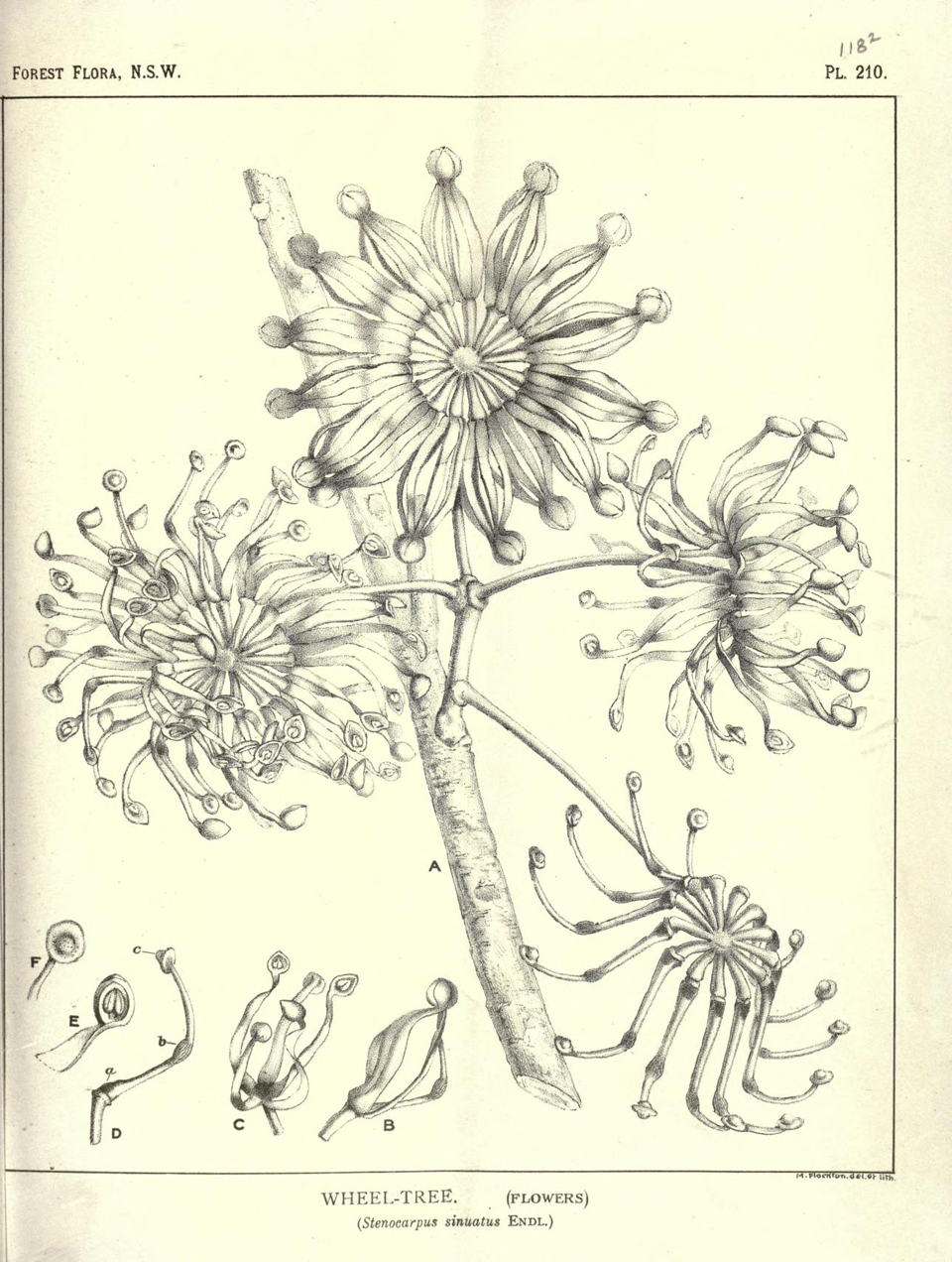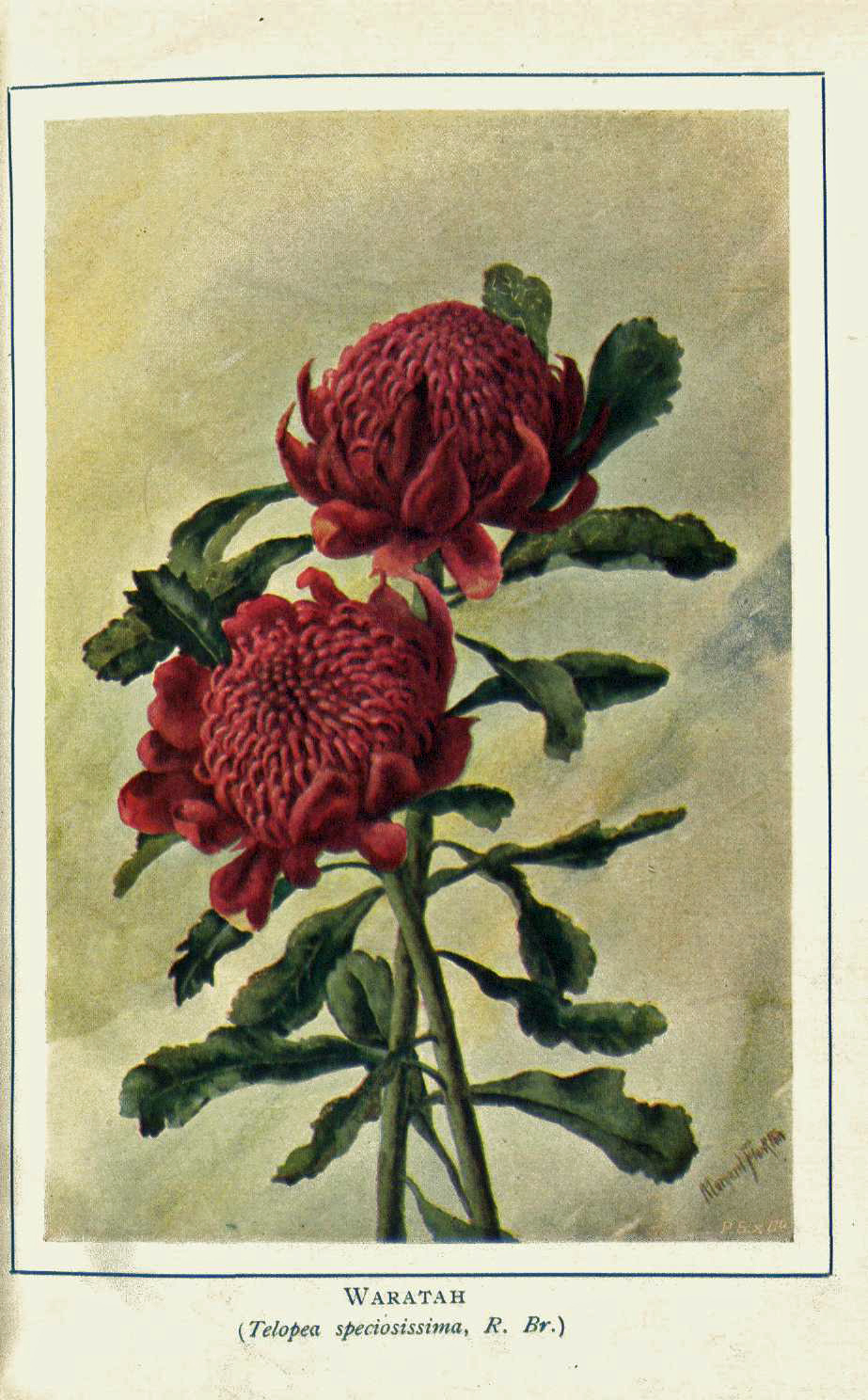The Dictionary of Sydney was archived in 2021.
Margaret Flockton at the Royal Botanic Gardens, Sydney
Citation
Persistent URL for this entry
To cite this entry in text
To cite this entry in a Wikipedia footnote citation
To cite this entry as a Wikipedia External link
Margaret Flockton at the Royal Botanic Gardens, Sydney
'the establishment of a Botanic Garden cannot be complete unless a resident draughtsman…be a part thereof' [1]
[media]The life of the first and longest serving botanical illustrator at the Royal Botanic Gardens, Sydney, Margaret Flockton, was barely recognised until the inception of the Margaret Flockton Award in 2004. Her name and skilful renderings of plants have now become well known in the botanical illustration field, a century after her time.
For hundreds of years, scientific plant drawings have aided the visual identification of plants for both the botanist and plant enthusiast. Botanical illustration at the Royal Botanic Gardens began with the establishment of the National Herbarium of New South Wales in 1901 and the appointment of Miss Margaret Lilian Flockton, aged 40.
With scientific accuracy, Flockton depicted the botanical subjects of the taxonomists and their assistants for the next 27 years, retiring from the Royal Botanic Gardens at the age of 67. [2]
A passion for nature
Margaret immigrated to Australia from England when she was 19. Born into a creative family in the United Kingdom in 1861, Margaret's pathway to becoming the first botanical illustrator at the Royal Botanic Gardens, Sydney, was a meandering and colourful one. Attending art schools first in Wales and then London, Margaret immigrated to Sydney in 1880 as perhaps the most thoroughly trained female artist in the country. As one of the first eight female artists who were taught the art of lithography in London, it was with this skill that she initially established her career in Sydney with publishers of the Illustrated Sydney News [3].
Following time spent with her family in rugged outback Queensland, a career change saw Margaret's artistic focus drawn to nature [4]. From 1894 to 1901 she taught art from her Sydney city studio, exhibiting alongside Australia's premier artists to outstanding acclaim with the Royal Art Society of New South Wales [5]. However, it was following the crucial decision to visit Sydney's Technological Museum (now the Powerhouse Museum) to paint displays of native flora, that she came to the notice of botanist Joseph Maiden, the then Director of the Royal Botanic Gardens. Such was the impression that Margaret had on Maiden she was officially invited to become the first botanical illustrator at the Gardens. Margaret's patience, passion for nature and rendering detail matched perfectly with her unique and valuable skills as a lithographer, as hundreds of botanically accurate drawings, lithographs and coloured sketches attest.
Scrupulous work
A century ago the process of illustrating was very similar to today's practice. A brief would be given from the taxonomist describing the species to be illustrated, highlighting specific features relative to its identification. Margaret would have used a form of microscope and sophisticated 'camera lucida' (a system of mirrors attached to a microscope allowing artwork and subject to be viewed simultaneously). Once initial sketches were completed and checked by the botanist, Margaret would have carefully arranged her compositions to be transferred to the lithographic stone for reproduction.
[media]The consistent high quality of Margaret's work is inspiring. Her major works include 88 plates completed for Joseph Henry Maiden's Critical Revision of the Genus Eucalyptus [6] and also the Forest Flora of NSW [7]. Her meticulous observation and flawless accuracy were complemented by a fine sense of composition and scale. Of hundreds of other works to note are those painted for Maiden's Opuntia (Prickly Pear) publication. [8]
Margaret [media]herself also collected specimens. She wrote and illustrated a small colour volume on Lichens [9] as well as The Wildflowers of Australia [10]. In total there are now almost 1,000 illustrations in the Royal Botanic Gardens and Domain Trust archive that can be attributed to Margaret Flockton.
Margaret's scrupulous work earned the highest respect of her friend and Director, Joseph Henry Maiden. Acknowledging her contribution to his Eucalyptus revision series, Maiden wrote:
…the help I have received from the artist of this work is immense…The faithfulness of the drawing sometimes brought out a hitherto unsuspected point…She is practically a joint author. [11]
Elsewhere, Maiden wrote that Margaret was 'the most accomplished botanical artist in NSW', [12] even naming a species of Eucalypt after her – Eucalyptus flocktoniae.
[media]In 1909, Margaret was entered in the Register of Salaries as earning £150 per annum [13], which was then, as today, equivalent to administration staff, technical assistants and horticulturists. Interestingly, this was almost a quarter of the Director's salary. Over the years, Maiden fought for wage increases for his staff. In 1927, when she retired, Margaret earned £330 pounds per annum – almost half the salary of the Director!
Botanical illustration today
Margaret was not replaced on her retirement so many scientific papers published to document new species went without illustrations. It wasn't until the early 1980s and the creation of another great botanical text, the Flora of New South Wales [14], that illustrators were again formally employed by the Royal Botanic Gardens and Domain Trust. Over the next ten years, 19 illustrators were employed on a contract basis, producing small pen and ink drawings of every single plant species occurring in NSW, native and naturalised. Many of these species had never been illustrated before. Most drawings were completed using only herbarium specimens – pressed, dried plants.
The necessity of a permanent, in-house illustrator has once again been realised. Since the 1990s, six artists have been employed to illustrate new, renamed and threatened species. Many of these have been published in Telopea, the Royal Botanic Gardens and Domain Trust's journal.
Accurate illustrations of plants are as relevant today as they were in Margaret's time, even with the improvement of photography. The illustrator can highlight diagnostic features of the species from various sources without ambiguity and combine these elements (such as fruits and flowers) together in one composition – a task impossible to achieve with a camera.
The techniques of lithography employed by Margaret Flockton are no longer used in botanical illustration. Materials have evolved from lithography, to ink on paper, to the present technique of ink on plastic drafting film.
Computers have also become an integral part of the illustration process, used for preliminary layout and design as well scanning and recording the final artwork.
The Royal Botanic Gardens and Domain Trust now houses an extensive illustration archive representing work from the late 1800s to the present. This archive is an amazing resource that is still referred to by botanists as well as government and community groups in search of an image of a plant that may have only been illustrated once or twice. The archive continues to grow, not only from the addition of current work but also with Margaret's work that is still being found in herbarium boxes, having been hidden for around a hundred years!
The Royal Botanic Gardens, Kew firmly established Marianne North as their first acclaimed illustrator. Margaret Flockton is finally being given the lasting credit due to her, for her enormous contribution to early Australian botanical illustration and taxonomy.
References
Margaret Lilian Flockton, Australian Wild Flowers: A Beautiful Coloured Series, Bookstall, Sydney, [1912?]
Joseph Henry Maiden, A Critical Revision of the Genus Eucalyptus, Government Printer, Sydney, 1903–1931
Joseph Henry Maiden, The Forest Flora of New South Wale, William Applegate Gullick, Government Printer Sydney, 1904
Joseph Henry Maiden, The Prickly Pears of Interest to Australians, William Applegate Gullick, Government Printer Sydney, 1914
Louise Wilson, 'A Fragrant Memory', unpublished manuscript. We are indebted to Louise's manuscript on her family history
Notes
[1] Sir Joseph Bank's Will quoted in Thomas Campbell, Samuel Carter Hall, Edward Bulwer et al (eds), The New Monthly Magazine, part 2, 1820
[2] 'Flockton, Lilian Margaret (1861–1953)', Australian National Herbarium website, http://www.anbg.gov.au/biography/flockton-lilian.html, accessed 20 May, 2014; 'Woman Artist Dies At 92', The Sydney Morning Herald, 22 August 1953, p 3, http://nla.gov.au/nla.news-article18381740, accessed 20 May, 2014
[3] Louise Wilson, 'A Fragrant Memory', unpublished manuscript. We are indebted to Louise's manuscript on her family history
[4] Louise Wilson, 'A Fragrant Memory', unpublished manuscript. We are indebted to Louise's manuscript on her family history
[5] 'Art Society's Exhibition', The Sydney Morning Herald, 29 September, 1894, p 7, http://nla.gov.au/nla.news-article13970164, accessed 20 May, 2014; 'Society of Arts', Evening News, 28 September 1895, p 4, http://nla.gov.au/nla.news-article10988637, accessed 20 May, 2014; 'The Art Society', Evening News, 25 August 1900, http://nla.gov.au/nla.news-article112589488, accessed 20 May, 2014; 'The Federal Art Show', Evening News, 5 January 1901, Supplement, http://nla.gov.au/nla.news-article114019196, accessed 20 May, 2014
[6] Joseph Henry Maiden, A Critical Revision of the Genus Eucalyptus, Government Printer, Sydney, 1903–1931
[7] Joseph Henry Maiden, The Forest Flora of New South Wale, William Applegate Gullick, Government Printer Sydney, 1904
[8] Margaret Lilian Flockton, 'Prickly Pears of NSW', in Joseph Henry Maiden, The Prickly Pears of Interest to Australians, William Applegate Gullick, Government Printer Sydney, 1914
[9] Margaret Lilian Flockton, 'Lichens Illustrated, Book I: Parmelias, stictacea, cladonias etc', 21 pages of watercolour illustrations, unpublished manuscript, collection of the Royal Botanic Garden Sydney Library
[10] Margaret Lilian Flockton, Australian Wild Flowers: A Beautiful Coloured Series, Bookstall, ca1912; newspaper advertisements between 1902–1909 show Margaret's small booklet of lithographs of Australian wildflowers for sale; see 'Advertising,' The Argus, Melbourne,18 November, 1902, p4, http://nla.gov.au/nla.news-article9067503, accessed 20 May, 2014; 'Advertising', The Sydney Morning Herald, 16 October 1909, p 4, http://nla.gov.au/nla.news-article15087615, accessed 20 May, 2014
[11] Joseph Henry Maiden, A Critical Revision of the Genus Eucalyptus, Government Printer, Sydney, 1903–1931
[12] Joseph Henry Maiden, A Critical Revision of the Genus Eucalyptus, Government Printer, Sydney, 1903–1931
[13] 'Brevities', Evening News, 12 February 1909, http://nla.gov.au/nla.news-article113353509, accessed 20 May, 2014
[14] Gwen Harden (ed), The Flora of New South Wales, vol 1–4, University of New South Wales Press, Sydney 1990–93





